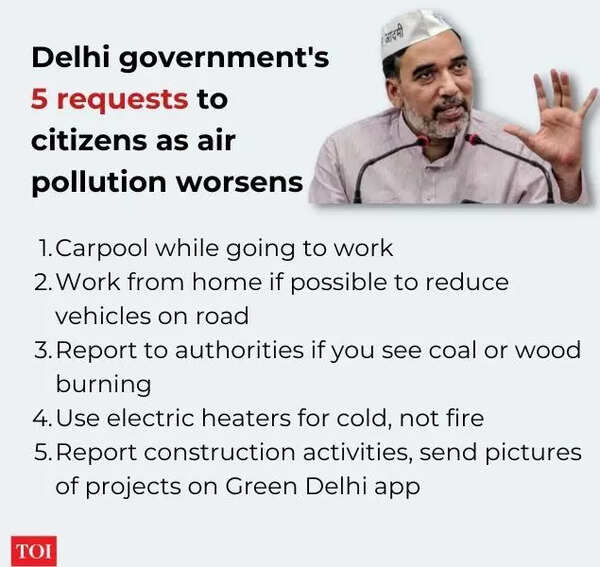Delhi AQI: How Delhi’s air pollution has gone off the charts | India News

On Friday morning, the air quality in the national capital jumped to 472. In Noida and Gurugram, it stood at 562 and 593 respectively — an abnormally high level. It meant that the people were effectively breathing smoke.
In some pockets of the city, the index exceeded 800, according Delhi Pollution Control Committee findings.
In view of the worsening air quality, the AAP government in Delhi on Friday ordered the closure of primary schools and curtailed outdoor activities for senior students. It also asked 50 per cent staff of the Delhi government to work from home.
According to the Centre, a reading of over 400 affects healthy people, with serious impacts on those with existing diseases.
Pushing the limits
Air quality in parts of Delhi is now consistently over 500, which is the maximum limit defined by the Centre. Beyond this, the air turns severely toxic.
There are six AQI categories, namely Good, Satisfactory, Moderately polluted, Poor, Very Poor, and Severe.
The AQI considers eight pollutants present in the air (PM10, PM2.5, NO2, SO2, CO, O3, NH3, and Pb) for which short-term (up to 24-hourly averaging period) National Ambient Air Quality Standards are prescribed.
An AQI between zero and 50 is considered “good”, 51 and 100 “satisfactory”, 101 and 200 “moderate”, 201 and 300 “poor”, 301 and 400 “very poor”, and 401 and 500 “severe”.
On Friday, Delhi’s 24-hour average air quality index spiralled to 450, just a notch short of the “severe plus” category.
According to the Centre, an AQI in the severe category can cause respiratory impact even on healthy people as well as serious health impact on people with lung/heart disease.
The health impacts can be experienced even during light physical activity.
Why is Delhi air so poisonous
The primary reason behind Delhi’s bad air is stubble burning.
According to SAFAR (System of Air Quality and Weather Forecasting And Research), stubble burning contributed 34 per cent in Delhi’s PM 2.5 pollution.
The burning of rice paddies after harvests across Punjab and other states persists every year despite efforts to persuade farmers to use different methods.
This is because farmers have to clear their fields ahead of the rabi season and burning of stubble is an efficient – and quickest – way to do it.
The widespread stubble burning in Punjab is actually a groundwater issue.
In Punjab, farmers are prohibited from planting paddy in May in order to prevent groundwater levels from going low before the monsoons. Groundwater depleting is turning into a big problem in Punjab and paddy is a water-intensive crop.
Thus, farmers in Punjab can only plant paddy from mid-June onwards. This has a cascading effect.
Due to the late sowing, the crops are harvested only in late October/early November. This coincides with the onset of winter season in north India when wind speeds slow down and temperatures drop.
If the sowing happened in May, the crops would harvest in September, which is windier and warmer in comparison.
Plus, most farmers in Punjab are poor and cannot afford machinery for clearing out stubble in the ground. They are left with no option but to resort to the cheaper solution of stubble burning.
Delhi government steps in
With air quality projected to get worse in the coming days, the Delhi government has stepped in to implement various curbs to alleviate the problem.
Speaking at a press conference on Friday, Delhi chief minister Arvind Kejriwal announced that primary schools will be closed from Saturday.
He said that outdoor sports activities for classes above fifth standard have also been suspended.

“This is not the time for blame game and politics, but time to find a solution to the problem. Blaming Kejriwal or the Punjab government won’t help,” the AAP chief said during the briefing.
Meanwhile, Delhi environment minister Gopal Rai ordered 50 per cent staff of the Delhi government to work from home and said an advisory will be issued to private offices to follow suit.
Earlier, Gopal Rai had suggested a 5-point plan to reduce pollution. He will convene a high-level meeting on Friday to discuss the implementation of curbs on polluting activities under the final stage of the Graded Response Action Plan.
(With inputs from agencies)




